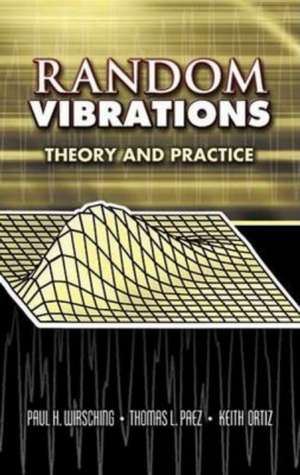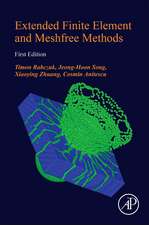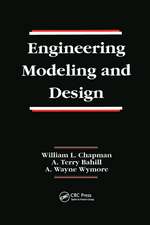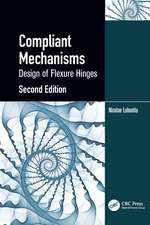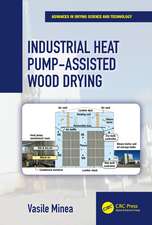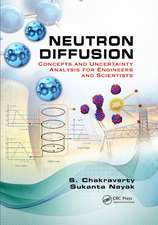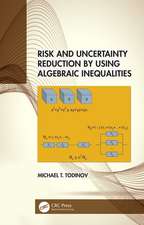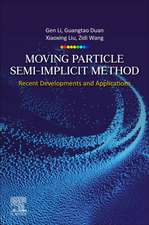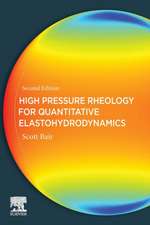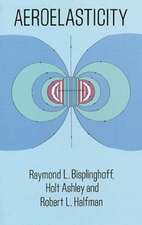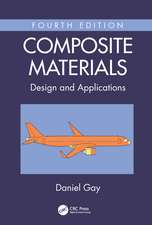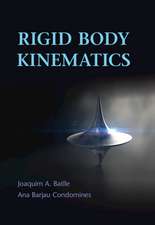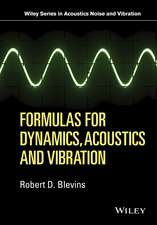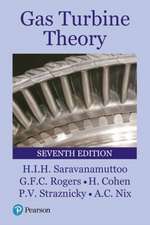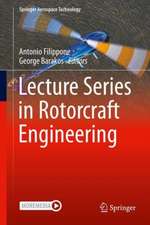Random Vibrations: Theory and Practice: Dover Books on Physics
Autor Paul H. Wirsching, Thomas L. Paez, Keith Ortizen Limba Engleză Paperback – 30 apr 2006
In addition to coverage of background topics in probability, statistics, and random processes, this text develops methods for analyzing and controlling random vibrations. It explains how to avoid fatigue and fracture brought on by random vibration stresses and describes how to analyze random signals obtained for field and test measurements. Detailed examples employ random signals taken from actual random sources, and an abundance of figures, tables and charts support and clarify the text.
Din seria Dover Books on Physics
-
 Preț: 115.27 lei
Preț: 115.27 lei -
 Preț: 167.44 lei
Preț: 167.44 lei -
 Preț: 72.15 lei
Preț: 72.15 lei - 17%
 Preț: 57.87 lei
Preț: 57.87 lei -
 Preț: 124.91 lei
Preț: 124.91 lei - 21%
 Preț: 130.62 lei
Preț: 130.62 lei -
 Preț: 82.70 lei
Preț: 82.70 lei - 22%
 Preț: 153.01 lei
Preț: 153.01 lei -
 Preț: 221.05 lei
Preț: 221.05 lei -
 Preț: 56.46 lei
Preț: 56.46 lei - 16%
 Preț: 77.06 lei
Preț: 77.06 lei -
 Preț: 128.24 lei
Preț: 128.24 lei - 21%
 Preț: 133.16 lei
Preț: 133.16 lei -
 Preț: 240.20 lei
Preț: 240.20 lei - 15%
 Preț: 265.63 lei
Preț: 265.63 lei -
 Preț: 224.33 lei
Preț: 224.33 lei - 18%
 Preț: 87.55 lei
Preț: 87.55 lei -
 Preț: 175.07 lei
Preț: 175.07 lei - 16%
 Preț: 245.01 lei
Preț: 245.01 lei -
 Preț: 156.47 lei
Preț: 156.47 lei -
 Preț: 71.11 lei
Preț: 71.11 lei -
 Preț: 101.77 lei
Preț: 101.77 lei - 22%
 Preț: 78.81 lei
Preț: 78.81 lei - 21%
 Preț: 184.80 lei
Preț: 184.80 lei -
 Preț: 106.83 lei
Preț: 106.83 lei -
 Preț: 93.60 lei
Preț: 93.60 lei - 15%
 Preț: 93.51 lei
Preț: 93.51 lei -
 Preț: 172.99 lei
Preț: 172.99 lei - 22%
 Preț: 155.66 lei
Preț: 155.66 lei - 22%
 Preț: 120.09 lei
Preț: 120.09 lei -
 Preț: 61.03 lei
Preț: 61.03 lei -
 Preț: 425.17 lei
Preț: 425.17 lei -
 Preț: 94.63 lei
Preț: 94.63 lei -
 Preț: 83.11 lei
Preț: 83.11 lei -
 Preț: 125.95 lei
Preț: 125.95 lei -
 Preț: 65.36 lei
Preț: 65.36 lei -
 Preț: 112.18 lei
Preț: 112.18 lei - 14%
 Preț: 117.20 lei
Preț: 117.20 lei -
 Preț: 112.18 lei
Preț: 112.18 lei - 16%
 Preț: 76.71 lei
Preț: 76.71 lei -
 Preț: 151.73 lei
Preț: 151.73 lei -
 Preț: 59.99 lei
Preț: 59.99 lei -
 Preț: 107.22 lei
Preț: 107.22 lei -
 Preț: 91.73 lei
Preț: 91.73 lei -
 Preț: 80.60 lei
Preț: 80.60 lei -
 Preț: 127.62 lei
Preț: 127.62 lei -
 Preț: 108.63 lei
Preț: 108.63 lei -
 Preț: 138.99 lei
Preț: 138.99 lei - 21%
 Preț: 156.72 lei
Preț: 156.72 lei -
 Preț: 83.87 lei
Preț: 83.87 lei
Preț: 140.82 lei
Nou
26.95€ • 29.29$ • 22.66£
Carte disponibilă
Livrare economică 31 martie-14 aprilie
Specificații
ISBN-10: 0486450155
Pagini: 448
Dimensiuni: 141 x 215 x 24 mm
Greutate: 0.49 kg
Editura: Dover Publications
Seria Dover Books on Physics
Textul de pe ultima copertă
By far the most comprehensive text available on random vibrations, Random Vibrations: Theory and Practice is designed for readers who are new to the subject as well as those who are familiar with the fundamentals and wish to study a particular topic or use the text as an authoritative reference. It is divided into three major sections: fundamental background, random vibration development and applications to design, and random signal analysis.
Introductory chapters cover topics in probability, statistics, and random processes that prepare the reader for the development of the theory of random vibrations and signal analysis. The second section develops this text's unique emphasis on the design of mechanical and structural systems for random vibration environments, with a focus on metal fatigue. The third section covers statistics, analysis of nonstationary random signals, the discrete Fourier transform, and the spectral analysis of random signals and systems driven by random inputs.
Numerous examples and exercises are presented throughout the text, and key concepts are clarified with an abundance of figures, charts, and graphs. To help familiarize the reader with the types of signals that will be encountered in practice, many of the random signals shown in the text aretaken from actual random sources.
Unequaled in the range of its coverage and the clarity of its presentation, Random Vibrations: Theory and Practice is both a suitable text for graduate level courses and an invaluable resource for mechanical, structural, and aerospace engineers.
The most comprehensive text and reference available on the study of random vibrations
Designed for graduate students and for mechanical, structural, and aerospace engineers, Random Vibrations: Theory and Practice encompasses all the key topics, including fundamental background material, random vibration development with applications to design, and random signal analysis. The broad scope of this text makes it useful both as a clear and thorough introduction to the field and as an authoritative reference for practitioners who wish to investigate special topics. Covers background topics in probability, statistics, and random processes Develops methods to analyze and control random vibrations Discusses how to avoid fatigue and fracture brought on by random vibration stresses Describes how to analyze random signals obtained from field and test measurements Provides detailed examples throughout the text with random signals taken from actual random sources Supplies an abundance of figures, tables, and charts that support and clarify the text material
